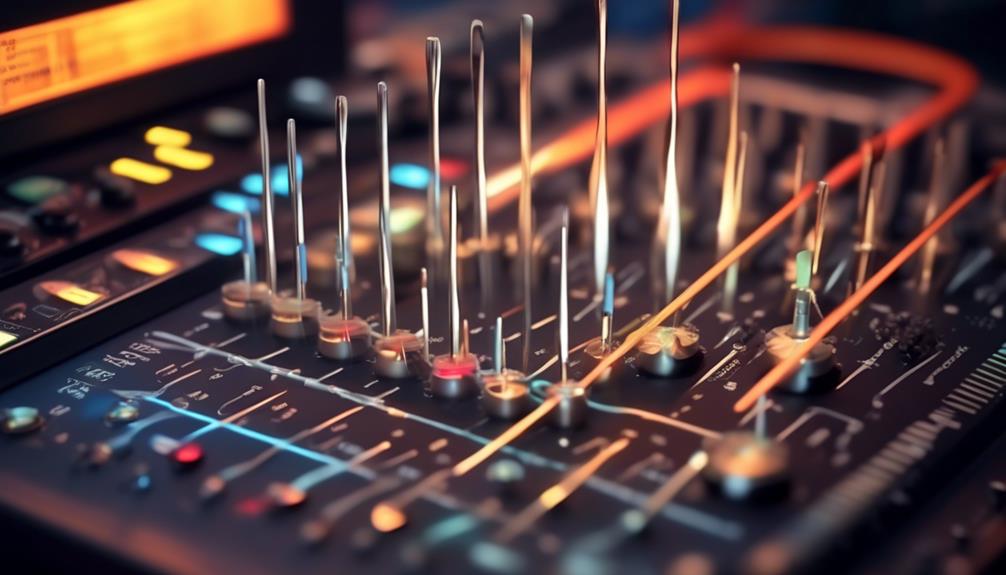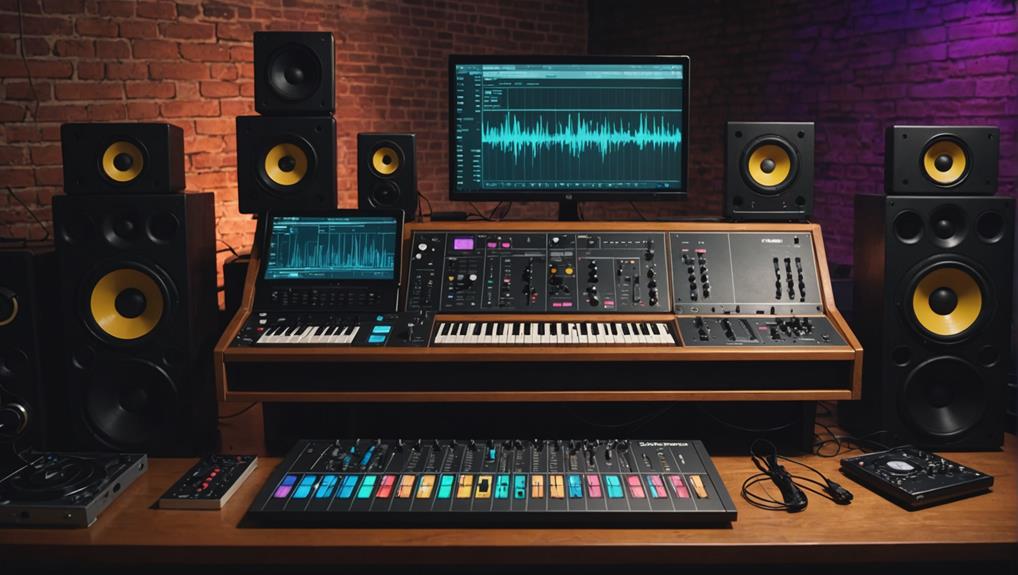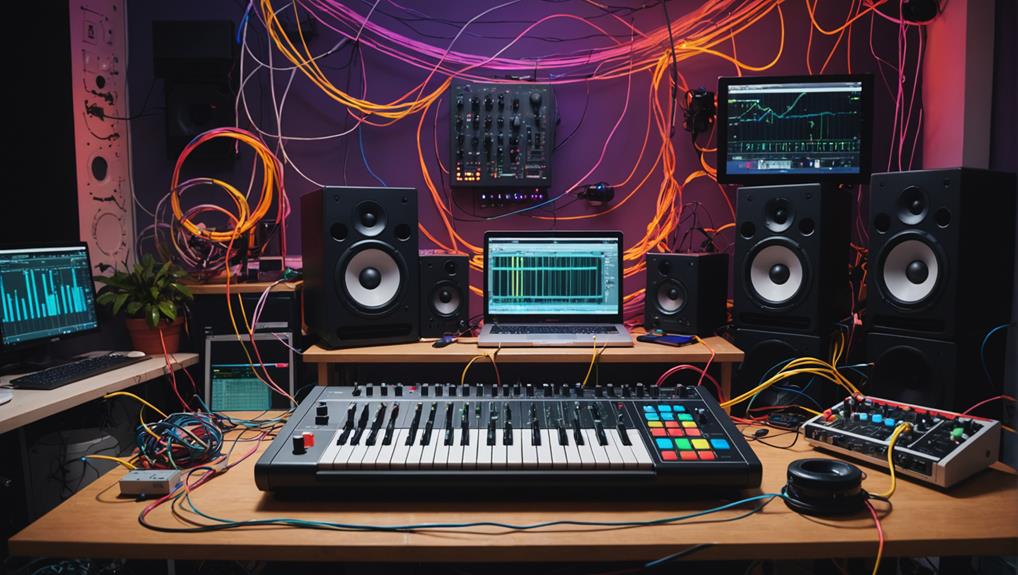You’ve undoubtedly heard the theory that A4 tuned to 432 Hz resonates more naturally with the universe than the standard 440 Hz, but have you ever wondered if there’s any validity to this claim?
As you sit with your instrument, ready to tune it, you’re participating in a tradition that stretches back to the very foundations of Western music. It’s a debate that not only involves the science of sound but also touches on the philosophy of aesthetics and the principles of acoustics.
The choice between 432 Hz and 440 Hz might seem trivial, yet it has the power to alter the subtle texture of music as you know it. Stay with this discussion, and you’ll uncover the layers of history, science, and emotion intertwined in a single note’s vibration, leading you to question how you perceive and experience music itself.
Key Takeaways
- The standard tuning for orchestras in the 20th century was set at A4 = 440 Hz, but it wasn’t until the mid-19th century that different countries began to adopt their own tuning standards.
- Pythagorean tuning, based on the ratio of 3:2 for perfect fifths, was limited in its use for modern music due to its inability to achieve certain intervals.
- The debate between 432 Hz and 440 Hz as the pitch standard for A4 is subjective, with arguments in favor of 432 Hz based on perceived natural and harmonious sound, but lacking scientific evidence.
- Experimenting with alternative tunings, such as 432 Hz, can lead to unique sounds, spark creativity, and potentially have positive effects on physical and emotional well-being, although more research is needed to fully understand these effects.
Historical Roots of Tuning
The historical roots of musical tuning trace back to the ancient mathematician Pythagoras, whose development of the Pythagorean tuning system laid the groundwork for the pursuit of harmonic perfection in Western music.
You’ll find, however, that Pythagorean tuning limitations have significantly influenced the evolution of musical scales. This system’s reliance on perfect fifths, based on a 3:2 ratio, resulted in intervals that were pure but not versatile enough for the chromatic nuances of modern music.
This rigidity meant certain intervals sounded dissonant, a stark contrast to the equal temperament system you’re accustomed to today. The impact on modern music is profound; the drive to overcome these constraints spurred the innovation of alternative tuning systems, better aligned with contemporary harmonic complexity.
Pythagorean System Explained
Building on the historical context of Pythagorean tuning’s influence on musical scales, let’s examine how this system uses mathematical ratios to create intervals that define the foundation of Western harmonic principles.
By stacking pure intervals of a 3:2 ratio, the Pythagorean system constructs a scale where the frequencies of notes are interrelated through simple, whole-number ratios. This relationship favors consonance in the tuning of perfect fifths, one of the system’s advantages.
However, the limitations of Pythagorean tuning become apparent when considering the resulting dissonance in other intervals, such as major thirds. These imperfections reflect the system’s inadequacy in supporting the full range of harmonic complexity found in contemporary music, pushing the boundaries of innovation and necessitating more versatile tuning solutions.
The 440 Hz Benchmark

By setting the A4 pitch at 440 Hz, musicians and instrument makers established a uniform standard that significantly streamlined international musical collaboration and instrument construction. The advantages of 440 Hz include global consistency, facilitating the mass production and compatibility of instruments. This ubiquity allows musicians to seamlessly integrate in ensembles worldwide, with a guaranteed baseline for tuning.
However, the drawbacks of 440 Hz shouldn’t go unnoticed. Some critics argue that this standard is arbitrary and overlooks the nuanced preferences that might favor alternate tunings, like 432 Hz, which some claim resonates more with natural frequencies and human physiology. While innovation often thrives on challenging norms, the entrenched 440 Hz standard presents a significant barrier to widespread adoption of alternative tunings.
Exploring 432 Hz Claims
Exploring the claims surrounding the 432 Hz tuning standard reveals a complex interplay between scientific skepticism and the search for a more harmonious musical experience. Proponents assert that 432 Hz tuning has unique effects on the brain and fosters deeper emotional resonance compared to the conventional 440 Hz standard.
- Scientific Evaluation:
- Limited empirical studies
- Inconclusive findings on neural impact
- Need for rigorous research
- Anecdotal Testimonies:
- Personal accounts of heightened emotions
- Claims of spiritual alignment
- Reports of therapeutic benefits
- Musical Application:
- Variability in listener sensitivity
- Subjective preference for timbral quality
- Artistic exploration of tuning’s effect on expression
Despite intriguing narratives, you’re encouraged to approach 432 Hz with a critical mind, recognizing that the field requires more definitive evidence to substantiate these claims.
Artistic Choices in Tuning

Artists often make deliberate choices in tuning standards to shape the unique character and emotional impact of their musical compositions. These decisions can have profound advantages and disadvantages for the texture and resonance of pieces, influencing the creative process of music production. A deviation from the norm, such as opting for A4=432 Hz, might yield a sound that resonates differently with listeners and performers alike.
| Advantage | Disadvantage |
|---|---|
| Creates a unique sonic signature | May cause compatibility issues |
| Can evoke specific emotional states | Requires recalibration of instruments |
| Sparks innovation in composition | Divides audiences and professionals |
| May align with artist’s philosophy | Impacts standardization in production |
This analytical exploration shows that tuning is not just a technical detail, but a strategic artistic choice.
Perceptual Effects on Listeners
The perceptual impact of tuning on listeners can vary greatly, with some individuals reporting a profound connection to music tuned at 432 Hz, while others may not discern any noticeable difference from the standard 440 Hz. Listener preferences are deeply personal and influenced by numerous variables, including cultural exposure and individual auditory sensitivity.
- Psychological effects:
- Emotional response
- Some listeners report a serene or more emotionally engaged experience at 432 Hz.
- Cognitive perception
- There may be subtle changes in how listeners process and remember music based on tuning.
- Physiological impact
- Although debated, certain frequencies are claimed to influence the body differently.
Analyzing these perceptual effects requires meticulous study, with a focus on innovative methodologies to unravel the complexities of auditory experience and preference.
Scientific Investigations

Scientific scrutiny has revealed that, despite anecdotal claims of the benefits of 432 Hz tuning, robust empirical evidence supporting its superiority over 440 Hz remains elusive.
You’re navigating a landscape where scientific research rigorously evaluates the physiological effects of musical tuning standards. Pioneering studies have sought to determine whether 432 Hz tuning exerts a distinct impact on the human body compared to the prevalent 440 Hz standard.
However, while preliminary data suggests potential influences on heart rate, blood pressure, and sleep patterns, the findings are far from conclusive.
As you delve into the nuances of this auditory inquiry, remember that innovation in music often stems from empirical validation. The quest for discernible physiological responses to 432 Hz tuning challenges researchers to produce more definitive and comprehensive results.
Practical Tuning Methods
Exploring practical tuning methods often leads musicians to employ a variety of tools and techniques to achieve their desired pitch standard with precision and ease. As you delve into exploring alternative frequencies, consider the nuanced adjustments required for each instrument:
- Tuning Forks:
- Standard A440 Hz for reference
- Custom A432 Hz for therapy benefits
- Consistent overtones for manual tuning
- Digital Tuners and Apps:
- Immediate feedback on pitch accuracy
- Versatile settings for various temperaments
- Software:
- Digital Audio Workstations (DAWs) adjustments
- Pitch-shifting plugins for experimentation
The Benefits of 432 Hz in therapy, although still under scientific scrutiny, suggest a calming effect on the listener. It’s worth noting that innovative tools and software enhance your ability to explore these subtle differences in tuning with efficiency and precision.
Frequently Asked Questions
How Have Different Musical Genres Outside of Western Classical Music Approached the Standardization of Tuning, and Have Any Notable Non-Western Genres Adopted Alternative Tuning Standards?
You’ve noticed that outside Western classical, genres like Indian classical embrace microtonal variations, defying rigid cultural tunings. Non-Western scales often rely on alternative standards, fostering rich, innovative soundscapes.
Are There Any Legal or Copyright Issues That Musicians Might Face When Releasing Music in Non-Standard Tunings Like 432 Hz, Especially When Covering Songs Originally Performed in 440 Hz?
You won’t face copyright or tuning legality issues for releasing music in 432 Hz, even when covering songs initially in 440 Hz, as pitch standard changes don’t infringe on copyright laws.
How Does the Human Voice Interact With Different Tuning Standards, and Are There Any Considerations Vocalists Should Keep in Mind When Performing With Instruments Tuned to 432 Hz Versus 440 Hz?
You’ll need to adapt your vocal strain and pitch perception when singing with instruments tuned to 432 Hz, as opposed to the standard 440 Hz, to ensure tonal harmony and vocal health.
What Is the Environmental Impact, if Any, of Producing Musical Instruments That Are Capable of Easily Switching Between Different Tuning Standards, Such as 432 Hz and 440 Hz?
You’ll find that producing versatile instruments impacts the environment through material sourcing and affects instrument lifespan, demanding innovative designs to minimize ecological footprints while ensuring durability and adaptability.
Can the Choice of Tuning Standard Have Implications for Music Therapy and Other Therapeutic Uses of Music, and How Might It Affect the Design of Therapeutic Music Programs or Research Studies?
Your choice of tuning standard can influence music therapy outcomes due to varying tuning perception and resonance effects, potentially shaping the design and research of innovative therapeutic music programs.
Conclusion
In your exploration of musical tuning, you’ve witnessed the evolution from Pythagorean roots to the 440 Hz standard.
You’ve scrutinized 432 Hz claims, appreciating the subjective artistry in tuning.
The perceptual impact on your ears is undeniable, yet scientific rigor demands more evidence.
As you fine-tune your understanding, remember that practical methods blend tradition with innovation.
Ultimately, the battle of standards isn’t just about frequency; it’s a symphony of history, culture, and the physics of sound.




